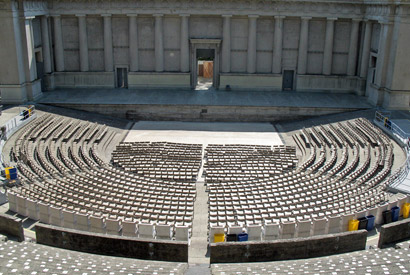Historic Greek Theatre safe, sound and superb after upgrades
The 108-year-old Greek Theatre's seismic rating has gone from "very poor" to "good" following six months of retrofit work and other upgrades.

May 24, 2012
Six months of major construction at the University of California, Berkeley’s 108-year-old William Randolph Hearst Greek Theatre – once rated “very poor” for seismic safety – is complete, providing an earthquake-safe, upgraded venue for graduation ceremonies, concerts and other events.
The open-air amphitheater, which seats 8,500 and is adjacent to the Hayward Fault, was in dire need of seismic and accessibility upgrades, as well as of repairs to key historic features. While the outdoor seating had no seismic issues, the stage’s three-sided, Greek-style colonnade, as well as the amphitheatre end walls, lacked reinforcement to withstand a major quake.
Inaugurated in 1903, the structure on the eastern edge of campus is listed on the National Register of Historic Places and has California Historic Landmark status. As a result, the seismic upgrades were completely concealed to maintain The Greek’s integrity.
“Sitting in the theater today, you’d never know anything has changed,” said Doug Warrick, general manager of Cal Performances, which oversees events at the theater. “The character of the building remains unchanged; the architectural details have been carefully preserved.
“But backstage, the dressing rooms have been upgraded for the first time since 1956, there are new bathrooms and a new elevator, and major improvements were made to the heating, ventilation, electrical and teledata systems.”
The path to The Greek from the main plaza off Gayley Road was improved to give better access for people with disabilities. Additional theater upgrades include increased lighting and a shiny new copper rooftop.
Seismic work on the $9.35 million project, paid for jointly by UC Berkeley and Cal Performances, involved underpinning existing foundations, reinforcing the columns and colonnade walls with reinforced concrete, retrofitting the auditorium’s concrete retaining walls, and connecting the brick and plaster decorative ornaments located high above the stage with stainless steel anchors.
“This is one of those projects where we strive to leave no fingerprints – if no one notices any changes to the historic structure, then we’ve done our job well,” said Chris Wasney, the project’s architect. “But in reality, it was an incredibly intricate insertion of modern structural systems into the century-old colonnade. The original construction was honeycombed with internal hollows and voids, and we were able to utilize these to hide our modern seismic strengthening systems.”
The theater’s seismic rating has been upgraded from “very poor” to “good,” and Wasney said he is confident the venue should provide another 100 years of service to the campus and the community.
Project team
Architect: Cody Anderson Wasney Architects
Engineer: Tipping Mar Structural Engineers
General Contractor: Overaa Construction
Project Management: UC Berkeley Capital Projects
The Greek Theatre, built in a natural hillside bowl in the hills above campus, was given as a gift to UC Berkeley in 1903 by William Randolph Hearst. Benjamin Ide Wheeler, who became the University of California’s president in 1899, had advocated for bringing a Greek amphitheater to campus. A professor of comparative philology and Greek, he had spent a year in Athens, and while there served as a judge for the first modern summer Olympic Games held in that city in 1896.
The principal design was done by University Architect John Galen Howard, who took as his model ancient theaters such as those at Epidaurus, Greece, and Pompeii, Italy, incorporating both Greek and Roman elements in his design.
U.S. President Theodore Roosevelt addressed UC’s graduating class of 1903 at The Greek, even though it was not quite finished. Wheeler knew the president from his days in New York, when Wheeler had been a professor at Cornell University and Roosevelt was governor of New York.
The San Francisco Chronicle, reporting on that first commencement ceremony, called The Greek “a great walled amphitheater such as has scarcely existed in the world since the memory days of Greece, one whose only roof was a perfect sky, azureous as that above Athens.”
World-renowned politicians and entertainers have appeared on the theater’s stage, and until recently, it was a venue for Commencement Convocation, which two years ago was moved to a larger campus space. Individual departmental graduation ceremonies still take place at The Greek during May, and Another Planet Entertainment produces concerts there between May and October.
Among other highlights of The Greek’s history:
- Sarah Bernhardt performed there in 1906 in a production of Jean Racine’s “Phaedre” as a benefit for victims of the San Francisco earthquake and fire.
- Mickey Rooney and Olivia de Haviland were among the actors performing “A Midsummer Night’s Dream” in 1934.
- The Big Game Bonfire Rally has been held annually at the theater since it opened in 1903.
- Theatrical and dance productions moved in 1958 from The Greek to the new Hertz Hall and Morrison Auditorium, then moved again in 1968 to the newly opened Zellerbach Hall and Playhouse. The Greek then emerged as a prime space for big-name concerts that have included Joan Baez, the Grateful Dead, Paul Simon and Adele.
- Presidents Roosevelt (1903, 1911) and Woodrow Wilson (1919); presidential candidates Eugene McCarthy and Robert Kennedy (1960); Secretary of State Madeleine Albright (2000), Attorney General Janet Reno (2001) and the Dalai Lama (2009) are among the famous individuals who have spoken there.